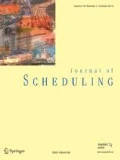Abstract
Westside High School (WHS) of Omaha, Nebraska utilizes a sophisticated scheduling environment called “modular scheduling.” Modular scheduling empowers teachers with the ability to design the structure of their classes by adjusting the frequency, duration, and location of each of their lessons. This paper presents a novel heuristic methodology, implemented as a computer program called the sequential modular algorithmic routines for timetabling (SMART) Scheduler, which creates cohesive modular class schedules using effective techniques such as ejection trees and student sectioning. In experimentation, the SMART Scheduler is able to schedule over 2,800 distinct lessons in less than 4 s using data provided by WHS. This paper describes algorithms within the SMART Scheduler as well as computational results of its implementation.



Similar content being viewed by others
References
Al Yakoob, S. M. (2007). A mixed-integer programming approach to a class timetabling problem: A case study with gender policies and traffic considerations. European Journal of Operational Research, 180(3), 1028.
Beligiannis, G. N. (2008). Applying evolutionary computation to the school timetabling problem: The Greek case. Computers Operations Research, 35(4), 1265.
Burke, E. K. (2003). A tabu-search hyperheuristic for timetabling and rostering. Journal of Heuristics, 9(6), 451.
Cambazard, H., Demazeau, F., Jussien, N., & David, P. (2005). Interactively solving school timetabling problems using extensions of constraint programming. Lecture Notes in Computer Science, 3616, 190–207.
Centre for Telematics and Information Technology (CTIT) Institute. Benchmarking project for high school timetabling. University of Twente. Accessed January 1, 2012, from http://www.utwente.nl/ctit/hstt/.
Ceschia, S., Gaspero, L., & Shaerf, A. (2012). Design engineering, and experimental analysis of a simulated annealing approach to the post-enrollment course timetabling problem. Computers and Operations Research, 39(7), 1615–1624.
Daskalaki, S., Birbas, T., & Housos, E. (2004). An integer programming formulation for a case study in university timetabling. European Journal of Operations Research, 153(1), 117–135.
De Haan, P., Landman, R., Post, G., & Ruizenaar, H. (2007). A case study for timetabling in a Dutch secondary school. Practice and theory of automated timetabling VI. Lecture Notes in Computer Science, 3867, 267–279.
Duong, T., Lam, K. (2004). Combined constraint programming and simulated annealing on University Exam Timetabling. Intl. Conf. RIVF’04.
Even, S. (1975). On the complexity of time table and multi-commodity flow problems. Foundations of Computer Science.
Guo, H., & Yan, J. (2011). Research of university course scheduling system based on evolutionary algorithm. Applied Informatics and Communication, Communications in Computer and Information Science, 225, 171–177.
Hertz, A. (2003). Tabu search for large scale timetabling problems. European Journal of Operational Research, 54(1), 39.
Lewis, R. (2007). A survey of metaheuristic-based techniques for university timetabling problems. OR-Spektrum, 30(1), 167.
Muggy, L. (August 2011). The SMART scheduler: A revolutionary scheduling system for secondary schools. Master’s Thesis submitted to Kansas State University.
Murray, K., Müller, T., & Rudova, H. (2007). Modeling and solution of a complex university course timetabling problem. Lecture Notes in Computer Science, 3867, 189–209.
Pillay, N. (2010). An overview of school timetabling. In Proceedings of the 8th international conference on the practice and theory of automated timetabling (pp. 321–335).
Santos, H. G., & Ochi, L. S. (2005). A tabu search heuristic with efficient diversification strategies for the class/teacher timetabling problem. ACM Journal of Experimental Algorithmics, 10, 2–9.
Santos, H. G., Uchoa, E., Ochi, L. S., & Maculan, N. (2012). Strong bounds with cut and column generation for class-teacher timetabling. Annals of Operations Research, 194(1), 399–412.
Schaerf, A. (1999). A survey of automated timetabling. The Artificial Intelligence Review, 13(2), 87.
Acknowledgments
The authors wish to thank the Principal and Head Scheduler at Westside High School for both their financial support and prompt responses to numerous questions. The authors would also like to thank three anonymous reviewers for their valuable comments, which helped to strengthen this paper.
Author information
Authors and Affiliations
Corresponding author
Rights and permissions
About this article
Cite this article
Muggy, L., Easton, T. Generating class schedules within a complex modular environment with application to secondary schools. J Sched 18, 369–376 (2015). https://doi.org/10.1007/s10951-014-0403-z
Received:
Accepted:
Published:
Issue Date:
DOI: https://doi.org/10.1007/s10951-014-0403-z




